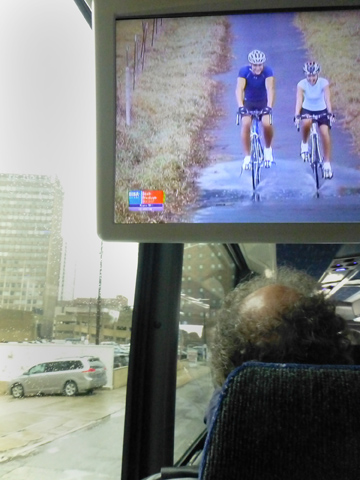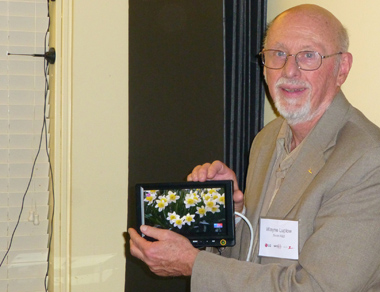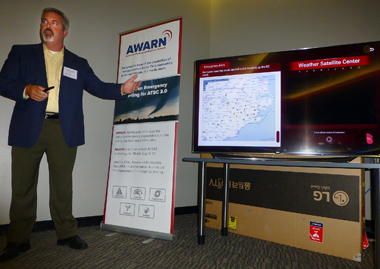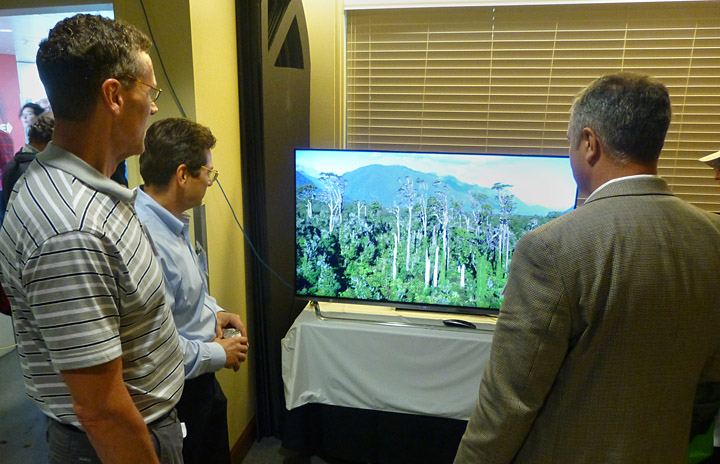Inside the Cleveland Futurecast ATSC 3.0 Transmission Tests

Journalists and observers were bused around Cleveland watching a Futurecast broadcast of 720p video. There was no breakup during the 30-minute bus ride on the highway and on city streets.
CLEVELAND—Work on a future ATSC 3.0 standard is moving swiftly, with officials from GatesAir, LG and Zenith’s research and development lab predicting that there will be a “candidate standard” by the end of this year. And with an experimental high-power ATSC 3.0 transmitter available for test broadcasts at any time during the day, the GatesAir/LG/Zenith Futurecast proposal shows some interesting data from recent tests in Cleveland.
Licensed as WI9X3Y in the Cleveland suburb of Parma, Ohio, and owned by WJW’s parent company Tribune Broadcasting, the full-power UHF station operates on Channel 31 with an ERP of 430 kW. This was the digital broadcasting plant for TV station WJW in Cleveland, which turned it off permanently during the analog shutdown in July 2009.
Until May 2015, when the Futurecast team consisting of GatesAir, LG and Zenith negotiated with WJM and the FCC to revive the digital broadcasting plant as a test bed for proposed ATSC 3.0 technology. Since then, the Futurecast team has conducted transmission tests of both ATSC 1.0 and ATSC 3.0 for extended hours, to gain experience with the capabilities of ATSC 3.0 and compare it to the existing standard.
A previous test of Futurecast was held last October in Madison, Wisc., where three early morning hours were set aside for an ATSC 3.0 demo. The Cleveland facility allows the same team to broadcast at any time without concern for viewers or the station’s schedule. The test participants said that some things learned in the Madison tests were accommodated in Cleveland.
“In Madison, we learned a few things in terms of acquisition and tweaked that for this test,” said Wayne Luplow, vice president of Zenith’s R&D lab.
75,000 DATA POINTS
Get the TV Tech Newsletter
The professional video industry's #1 source for news, trends and product and tech information. Sign up below.

Wayne Luplow, vice president of Zenith’s R&D lab, holds a display showing Futurecast’s robust SD feed. The antenna picking up the signal is the small horizontal whip in the upper left of the photo.
To date, the Cleveland test has collected information from more than 75,000 data points. These include far more challenging conditions than those experienced in Madison, including tall downtown buildings as well as transmission near a large body of water (Lake Erie). John Taylor, vice president for public affairs and communications for LG Electronics, said that there was continual improvement since the Madison test, particularly with software for mobile acquisition and improved multipath performance.
Some of the important findings so far have compared the Futurecast ATSC 3.0 technology with the current ATSC 1.0 A/153 mobile standard. The data collected by the Cleveland team shows that Futurecast’s semi-robust HD stream (720p) is only a bit less robust than the A/153 mobile standard: Futurecast can get a solid HD signal through about 78 percent of the time, while A/153 scores about 83 percent but with much lower-quality video. Futurecast’s most robust mode scores a solid reception score of 91 percent, and that is with a clean DVD-quality SD video feed. The current ATSC A/153 mobile system has a video feed that is sub-SD in quality. The modulation and encoding are such that the most robust Futurecast signal can be received even if noise exceeds the signal level by 1.2 dB.

Pete Socket with WRAL-TV leads a presentation on AWARN, the emergency warning system built into the Futurecast proposal.
The Futurecast ATSC 3.0 proposal uses OFDM modulation and HEVC encoding. The modulation scheme means that a 6 MHz broadcast channel can carry about 26 Mbps of data, while HEVC encoding—sometimes referred to as MPEG-5—means that video streams have considerably more efficient encoding than the MPEG-2 encoding used for ATSC 1.0.
As in Madison, the Futurecast broadcast consisted of three simultaneous streams: 256QAM at 15.7 Mbps for a 4K stream, 16QAM at 1.25 Mbps for the semi-robust 720p stream and QPSK at 0.59 Mbps for the ultra-robust 480p signal.
SWEEPING OUT THE COBWEBS
Prepping WJM’s old digital transmitter for around-the-clock Futurecast testing took more than just sweeping out the cobwebs from a facility that hadn’t been used in six years. The transmitter—which is not a GatesAir/Harris product—needed two of its three IOT tubes replaced. Even with tube replacement and other re-commissioning work, the transmitter can be finicky.
“When you turn it off for a couple of weeks, it’s like starting from scratch,” said Tribune Broadcasting’s director of engineering operations Bill VanDuynhoven. “We’re still working on it.”

From left to right: Bud Bush of WQHS, TR Stoner of Univision/Cincinnati and Dave Benco of GatesAir examine a 4K Futurecast broadcast.
In addition to a look at some of the data from Futurecast’s tests, the Cleveland presentation included a discussion of an advanced early warning system called AWARN that is incorporated into the ATSC 3.0 proposal. With AWARN, far more than just an emergency announcement crawl can be transmitted. The warning information can include maps, detailed full-motion video weather reports and other emergency information, even as the main broadcast continues uninterrupted.
Another tantalizing possibility with Futurecast and AWARN is a “wake-up bit” that can turn a TV on or switch it to emergency information in the event of an imminent disaster. This is still being worked out, but the goal is to target warnings by geography, so that TVs located 25 miles east of a transmitter aren’t affected by an emergency event 25 miles west of the transmitter.
Turnout for the Cleveland event—part of which was held at the Rock & Roll Hall of Fame—was excellent, with more than 60 attendees. Many of them were engineers from TV stations in or near Cleveland, and it was the first time many of them had seen an over-the-air 4K broadcast.
Looking at the off-air signal on a 4K display, it didn’t take long for some to see the possibility in 4K broadcasts.
“The video encoding [in the Futurecast broadcast] is so much better than what we have,” said Karl Lahm, an engineer with a Univision broadcaster in Cleveland.
Other than a new encoder/modulator, Futurecast is designed to work with current digital transmitters and all existing passive RF gear, such as antennas and mask filters. The only other change to the transmitter is to reduce its power slightly (by 0.5 dB or so) due to the higher peak-to-average ratio of Futurecast’s modulation.
Bob Kovacs is the former Technology Editor for TV Tech and editor of Government Video. He is a long-time video engineer and writer, who now works as a video producer for a government agency. In 2020, Kovacs won several awards as the editor and co-producer of the short film "Rendezvous."

